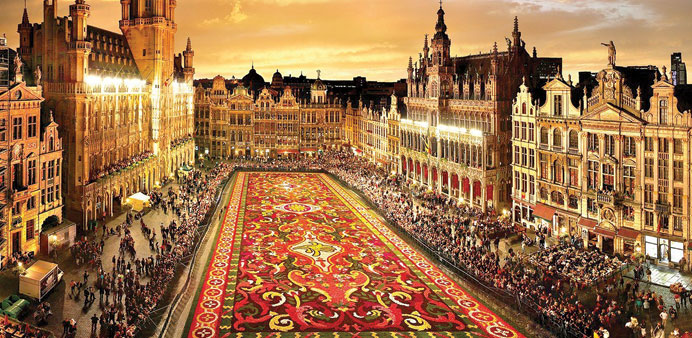Nobody knows a place like the people living there. James Rogers has been in Brussels
for the past 11 years and shares information about the city’s battlefields, art, chocolates,
history and more with John Borsden
What’s it like to live in a far-off place most of us see only on a vacation? Foreign correspondence is an interview with someone who lives in a spot you may want to visit.
This is a foreign correspondence with James Rogers, 45, who is originally from North Dakota and is a writer who settled in Brussels, Belgium, 11 years ago. He is finishing his first book, 96 Degrees of Separation: The Parallel Lives of Adam & Yves, about how government policies make everyday life different for Europeans and Americans.
Q. Where do you live in Brussels?
A. I lived in the city centre until two years ago. When my wife and I had a second child we moved to Genval, a suburb in the French-speaking part of Belgium, near Waterloo.
Q. Waterloo is the site of the famous battle Napoleon lost. It must be like living next to Gettysburg.
A. Except that the battlefield wasn’t preserved to look exactly the way it looked in 1815. After the battle, Belgium became a part of the new United Kingdom of the Netherlands, and the Dutch king had workers dig up dirt from the battlefield to build a steep, pyramid-like hill that can be seen from miles away.
On top of it is a statue of a lion with its paw resting on a ball — symbolising, I think, the “global” victory: Six countries’ armies were fighting France.
It’s a popular place, with a tourist centre and a small museum, but usually you don’t have to wait a long time — except once every five years, when they re-enact the battle.
Next year, the 200th anniversary, should be amazing to see. The north of Belgium also has well-known World War I battlefields such as Ypres. Like in the poem, “In Flanders fields the poppies blow ...”
Q. Flanders is Dutch-speaking, while in Wallonia — southern Belgium — the language is French. How does that work?
A. Outside of Brussels, which is a separate, bilingual region, there is a clear language divide. As a rule — I mean that literally — all the signs in Flanders are in Dutch, and all the signs in Wallonia are in French — though the Flemish are far more strict about this. Brussels, for historical reasons, is 80% French-speaking, despite being geographically surrounded by Flanders — something the Flemish like to point out by having an annual bike race called De Gordel — Dutch for “belt” — because the route makes a belt around the capital.
Q. Do the two languages make things complicated for tourists? Do you need two phrasebooks to get by?
A. Most Belgians speak English, too, and... Belgians are thrilled to practice their English with a tourist. And Brussels is not just the capital of Belgium, it’s the capital of Europe: People from 28 countries come here to work for the European Union — go for drinks at Place Luxembourg (next to the EU Parliament) and you’ll hear “Eurocrats” from all these countries speaking English to each other over beer and fries.
Q. Where’s a good place in Brussels to try Belgian food?
A. One quintessential Belgian place is Les Brassins, in the Ixelles neighbourhood of Brussels, right in the heart of things — near shopping and museums — on a side street called rue Keyenveld. It’s a couple doors down from Audrey Hepburn’s birthplace. The menu has Belgian classics like mussels, carbonnade flamande and waterzooi, which reminds me of a pot pie without the crust but is better than that. They have good steaks, too, but beware the “filet Americain”: It’s actually raw hamburger with a side of mayo and other mix-ins. The story? I’ve heard that when the Americans liberated Belgium during World War II, the GIs handed out raw hamburger patties to the people, and it caught on.
Q. What are the must-see attractions?
A. Probably the biggest draws are the Grand-Place, a medieval square and a UNESCO World Heritage Site, and the Royal Museums, where there’s an all-Rubens wing as well as David’s masterpiece, “Death of Marat.” I’d start at the latter so you can walk downhill, but first check out the (Rene) Magritte Museum next door — it’s the world’s biggest collection of the famous surrealist’s work. On your way down to the Grand-Place is the Grand Sablon, a fancy square where all the famous chocolate makers have shops. In addition to Godiva and Neuhaus, there are two you cannot get in the States: Marcolini and Wittamer. Pierre Marcolini is sort of the Prada of dark chocolate — minimalist design and packaging. Wittamer is the opposite — bright lights, bright pink boxes, and more emphasis on milk chocolates.
For travellers, the greatest thing about Brussels is that it’s so close to so many other places. Bruges, a perfectly preserved medieval city, and its modern sister city of Ghent, both have amazing sights and are just a short train ride away. You can even visit four different countries in four days — American friends visit me a lot because of this: Aachen, Germany, and Lille, France, are both 90 minutes away; Maastricht, a cute Dutch university town, is even closer. — The Charlotte Observer/MCT

IMPRESSIVE: The Grand-Palace is the medieval heart of Brussels, Belgium.
